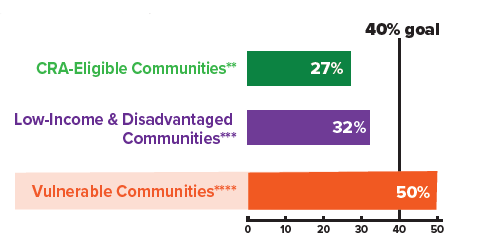Strategy + Impact
Since the Connecticut Green Bank’s inception through the bipartisan legislation in July 2011, we have mobilized nearly $3 billion of investment into the State’s green economy.
Strategy + Impact
Since the Connecticut Green Bank’s inception through the bipartisan legislation in July 2011, we have mobilized nearly $3 billion of investment into the State’s green economy.
We have attracted $2.88 billion in private investment using only $409.4 million in Green bank dollars, a leverage ratio of $7.00 for every $1. The impact of our deployment of renewable energy and energy efficiency to families, businesses, and our communities is shown in terms of economic development, environmental protection, equity, and energy (data from FY 2012 through FY 2024).*
* Includes projects, deployment, and investments approved, but not yet interconnected under Energy Storage Solutions.
ECONOMIC DEVELOPMENT
Jobs
The Green Bank has supported the creation of more than 29,248 direct, indirect, and induced job-years.

Tax Revenues
The Green Bank’s activities have helped generate an estimated $148 million in state tax revenues.
$56.4 million
individual
income tax
$58.0 million
corporate taxes
$32.0 million
sales taxes
$1.5 million
property taxes
ENERGY
Energy Burden
The Green Bank has reduced the energy costs on families, businesses, and our communities.

Deployment
The Green Bank has accelerated the growth of renewable energy to more than 707.2 MW and lifetime savings of over 89.3 million MMBTUs through energy efficiency projects.
ENVIRONMENTAL PROTECTION
Pollution
The Green Bank has helped reduce air emissions that cause climate change and worsen public health, including 7.0 million pounds of SOx and 8.7 million pounds of NOx.
11.4 million tons of CO2 equals

172 million
tree seedlings
grown for 10 years
![]()
2.3 million
passenger vehicles
driven for one year

Public Health
The Green Bank has improved the lives of families, helping them avoid sick days, hospital visits, and even death.
$218.9 – $494.9 million
lifetime public health value created
EQUITY
Investing
Investing in vulnerable communities, The Green Bank has set goals to reach 40% investment in communities that may be disproportionately harmed by climate change.
** Community Reinvestment Act (CRA) Eligible Communities – households at or below 80% of Area
Median Income (AMI)
*** Low-Income and Disadvantaged Communities – those within federal Climate and Economic Justice
Screening Tool and Environmental Justice Screening Tool
**** Vulnerable Communities – consistent with the definition of Public Act 20-05, including low- to
moderate-income communities (i.e., less than 100% AMI), CRA-eligible communities, and environmental
justice communities (e.g., including DECD distressed communities)
To download and print this fact sheet, please click here.
Link to: Investment Strategy
Investment Strategy
We leverage a public-private financing model to create solutions that increase the number of clean energy projects statewide.
Link to: Planning
Planning
The Connecticut Green Bank follows a comprehensive plan to fulfill its mission. Read our plans and budgets for 2022 and beyond
Link to: Reporting and Transparency
Reporting & Transparency
The Green Bank values transparency and responsible stewardship of ratepayer funds as management principles and a cornerstone of our leadership.
Link to: Evaluations
Evaluation
Learn how we guide the assessment, monitoring, reporting and evaluations of our program impacts and processes.
Link to: Societal Impact
Societal Impacts
Our work increases the investment and deployment of clean energy, which results in benefits to our economy, environment, energy, and equity.
Link to: Mapping Analysis of Your Area (MAYA) Tool
Mapping Analysis of Your Area (MAYA) Tool
See our impact on Connecticut by geographies, including county, city, utility service, political district, and census tract.
Link to: Successful Legacy Programs
Successful Legacy Programs
These past programs and projects tell the story of the Green Bank’s innovative approach to deploying green energy.


